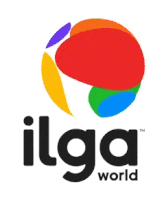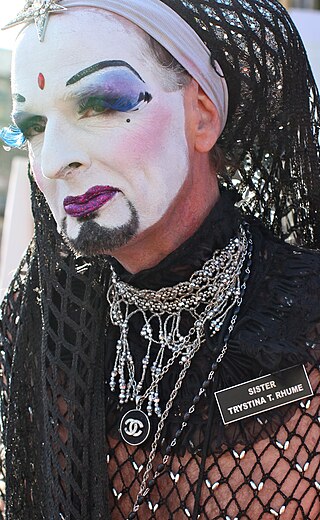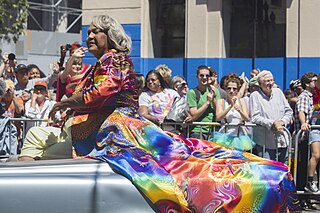Related Research Articles

Queer is an umbrella term for people who are not heterosexual or are not cisgender. Originally meaning 'strange' or 'peculiar', queer came to be used pejoratively against LGBT people in the late 19th century. Beginning in the late 1980s, queer activists, such as the members of Queer Nation, began to reclaim the word as a deliberately provocative and politically radical alternative to the more assimilationist branches of the LGBT community.

LGBT is an initialism that stands for "lesbian, gay, bisexual, and transgender". It may refer to anyone who is non-heterosexual, non-heteroromantic, or non-cisgender, instead of exclusively to people who are lesbian, gay, bisexual, or transgender. A variant, LGBTQ, adds the letter Q for those who identify as queer or are questioning their sexual or gender identity. Another variation, LGBTQ+, adds a plus sign "represents those who are part of the community, but for whom LGBTQ does not accurately capture or reflect their identity". Many further variations of the acronym exist, such as LGBT+, LGBTQIA+, and 2SLGBTQ+. The LGBT label is not universally agreed to by everyone that it is generally intended to include. The variations GLBT and GLBTQ rearrange the letters in the acronym. In use since the late 1980s, the initialism, as well as some of its common variants, functions as an umbrella term for marginalized sexualities and gender identities.

The International Lesbian, Gay, Bisexual, Trans and Intersex Association (ILGA) is a LGBTQ+ rights organization.
Riki Anne Wilchins is an American activist whose work has focused on the impact of gender norms.
Gender expression, or gender presentation, is a person's behavior, mannerisms, and appearance that are socially associated with gender, namely femininity or masculinity. Gender expression can also be defined as the external manifestation of one's gender identity through behavior, clothing, hairstyles, voice, or body characteristics. Typically, a person's gender expression is thought of in terms of masculinity and femininity, but an individual's gender expression may incorporate both feminine and masculine traits, or neither. A person's gender expression may or may not match their assigned sex at birth. This includes gender roles, and accordingly relies on cultural stereotypes about gender. It is distinct from gender identity.

A gender bender is a person who dresses up and presents themselves in a way that defies societal expectations of their gender, especially as the opposite sex. Bending expected gender roles may also be called a genderfuck.

Jack Halberstam, also known as Judith Halberstam, is an American academic and author, best known for his book Female Masculinity (1998). His work focuses largely on feminism and queer and transgender identities in popular culture. Since 2017, Halberstam has been a professor in the department of English and Comparative Literature and the Institute for Research on Women, Gender, and Sexuality at Columbia University. Previously, he worked as both director and professor at The Center for Feminist Research at University of Southern California (USC). Halberstam was the associate professor in the Department of Literature at the University of California at San Diego before working at USC.
A soft butch, or stem (stud-fem), is a lesbian who exhibits some stereotypical butch traits without fitting the masculine stereotype associated with butch lesbians. Soft butch is on the spectrum of butch, as are stone butch and masculine, whereas on the contrary, ultra fem, high femme, and lipstick lesbian are some labels on the spectrum of lesbians with a more prominent expression of femininity, also known as femmes. Soft butches have gender expressions of women, but primarily display masculine characteristics; soft butches predominantly express masculinity with a touch of femininity.
Over the course of its history, the LGBT community has adopted certain symbols for self-identification to demonstrate unity, pride, shared values, and allegiance to one another. These symbols communicate ideas, concepts, and identity both within their communities and to mainstream culture. The two symbols most recognized internationally are the pink triangle and the rainbow flag.

The questioning of one's sexual orientation, sexual identity, gender, or all three is a process of exploration by people who may be unsure, still exploring, or concerned about applying a social label to themselves for various reasons. The letter "Q" is sometimes added to the end of the acronym LGBT ; the "Q" can refer to either queer or questioning.

LGBT movements in the United States comprise an interwoven history of lesbian, gay, bisexual, transgender and allied social movements in the United States of America, beginning in the early 20th century. A commonly stated goal among these movements is social equality for LGBT people. Some have also focused on building LGBT communities or worked towards liberation for the broader society from biphobia, homophobia, and transphobia. LGBT movements organized today are made up of a wide range of political activism and cultural activity, including lobbying, street marches, social groups, media, art, and research. Sociologist Mary Bernstein writes: "For the lesbian and gay movement, then, cultural goals include challenging dominant constructions of masculinity and femininity, homophobia, and the primacy of the gendered heterosexual nuclear family (heteronormativity). Political goals include changing laws and policies in order to gain new rights, benefits, and protections from harm." Bernstein emphasizes that activists seek both types of goals in both the civil and political spheres.
LGBT linguistics is the study of language as used by members of LGBT communities. Related or synonymous terms include lavender linguistics, advanced by William Leap in the 1990s, which "encompass[es] a wide range of everyday language practices" in LGBT communities, and queer linguistics, which refers to the linguistic analysis concerning the effect of heteronormativity on expressing sexual identity through language. The former term derives from the longtime association of the color lavender with LGBT communities. "Language", in this context, may refer to any aspect of spoken or written linguistic practices, including speech patterns and pronunciation, use of certain vocabulary, and, in a few cases, an elaborate alternative lexicon such as Polari.

Transmisogyny, otherwise known as trans-misogyny and transphobic misogyny, is the intersection of transphobia and misogyny as experienced by trans women and transfeminine people. The term was coined by Julia Serano in her 2007 book Whipping Girl to describe a particular form of oppression experienced by trans women. In an interview with The New York Times, Serano explores the roots of transmisogyny as a critique of feminine gender expressions which are "ridiculed in comparison to masculine interests and gender expression."
Transgender studies, also called trans studies or trans* studies, is an interdisciplinary field of academic research dedicated to the study of gender identity, gender expression, and gender embodiment, as well as to the study of various issues of relevance to transgender and gender variant populations. Interdisciplinary subfields of transgender studies include applied transgender studies, transgender history, transgender literature, transgender media studies, transgender anthropology and archaeology, transgender psychology, and transgender health. The research theories within transgender studies focus on cultural presentations, political movements, social organizations and the lived experience of various forms of gender nonconformity. The discipline emerged in the early 1990s in close connection to queer theory. Non-transgender-identified peoples are often also included under the "trans" umbrella for transgender studies, such as intersex people, crossdressers, drag artists, third gender individuals, and genderqueer people.

The following outline offers an overview and guide to LGBT topics.
Iain Morland is a British music technologist and author. He formerly lectured in cultural criticism at Cardiff University. His writings focus on issues of gender and sexuality, medical ethics, and science. In 2005, Times Higher Education described Morland as a leading academic in the field of sex research. He has edited an edition of the journal GLQ, and co-authored Fuckology, a critical analysis of the writings and practices of John Money. With Lih-Mei Liao, Morland co-founded in 2002 Critical Sexology, a continuing interdisciplinary seminar series on gender and sexuality. His audio work includes audio editing, sound design and programming.

Intersex people are born with sex characteristics that "do not fit the typical definitions for male or female bodies". They are substantially more likely to identify as lesbian, gay, bisexual, or transgender (LGBT) than endosex people, an estimated 52% identifying as non-heterosexual and 8.5% to 20% experiencing gender dysphoria. Although many intersex people are heterosexual and cisgender, this overlap and "shared experiences of harm arising from dominant societal sex and gender norms" has led to intersex people often being included under the LGBT umbrella, with the acronym sometimes expanded to LGBTI. Some intersex activists and organisations have criticised this inclusion as distracting from intersex-specific issues such as involuntary medical interventions.
LGBT erasure refers to the tendency to intentionally or unintentionally remove LGBT groups or people from record, or downplay their significance, which includes lesbian, gay, bisexual, transgender, and queer people. This erasure can be found in a number of written and oral texts, including popular and scholarly texts.
Homonormativity is the adoption of heteronormative ideals and constructs onto LGBT culture and identity. It is predicated on the assumption that the norms and values of heterosexuality should be replicated and performed among homosexual people. Those who assert this theory claim homonormativity selectively privileges cisgendered homosexuality as worthy of social acceptance.

Masculine of center is a broad gender expression term used to describe a person who identifies or presents as being more masculine than feminine. It is most frequently used by lesbian, queer or non-binary individuals – generally those assigned female at birth. The term was coined by B. Cole as an umbrella term to encompass several labels used by lesbian, gay, bisexual, and transgender (LGBT) people of color while describing their more-masculine gender identity. Masculine of center is most often used in communities of color, and has implicit sociocultural connotations to both gender equality and racial justice.
References
- ↑ Siddons, Interview by Edward (2019-08-15). "Del LaGrace Volcano's best photograph: my blue mascara masculinity". The Guardian. ISSN 0261-3077 . Retrieved 2020-08-24.
- ↑ "Here's LaGrace!". QX Magazine. 2014-07-31. Retrieved 2019-03-19.
- ↑ "MaPa Del | Del LaGrace Volcano". www.dellagracevolcano.se. Archived from the original on 2019-04-01. Retrieved 2019-04-01.
- ↑ "Del LaGrace Volcano". The Emergence of 'Trans'. 2013-12-12. Retrieved 2019-04-01.
- ↑ Volcano, Del LaGrace (1999). The Drag King Book. Blackstock Mews, London: Serpent's Tail. p. 10. ISBN 978-1852426071.
- ↑ Wilton, Tamsin. glbtq: An Encyclopedia of Gay, Lesbian, Bisexual, Transgender, and Queer Culture. Chicago: glbtq, inc, 2002"Grace, Della"
- ↑ O’Riordan, Kate (2015), "Transgender Activism and the Net", Global Activism, Global Media, Pluto Press, pp. 179–193, doi:10.2307/j.ctt183q4qr.18, ISBN 9781849644778
- ↑ Steinbock, Eliza (2014-11-01). "Generative Negatives Del LaGrace Volcano's Herm Body Photographs". TSQ: Transgender Studies Quarterly. 1 (4): 539–551. doi:10.1215/23289252-2815228. ISSN 2328-9252.
- ↑ Volcano, Del LaGrace; Prosser, Jay; Steinbock, Eliza (2016-01-01). Horlacher, Stefan (ed.). Transgender and Intersex: Theoretical, Practical, and Artistic Perspectives. Palgrave Macmillan US. pp. 189–224. doi:10.1057/978-1-349-71325-7_8. ISBN 9781137543523.
- ↑ "Artist's Statement Archived 2016-09-10 at the Wayback Machine ". Del LaGrace Volcano official website.
- ↑ Halberstam, J. Jack (2005). In a Queer Time and Place: Transgender Bodies, Subcultural Lives. USA: NYU Press. p. 178. ISBN 9780814735855.
- ↑ Reed, Christopher (2011). Art and Homosexuality: A History of Ideas. USA: Oxford University Press. pp. 237–239. ISBN 9780199830442.
- ↑ Levine, JJ (April 2015). "Whipping the Binary". Photography and Culture. 7 (3): 304. doi:10.2752/175145214X14153800234892. S2CID 191482291.
- ↑ "Publications [ permanent dead link ]". Del LaGrace Volcano official website.
- ↑ Gabb, Jacqui (November 1998). "Marginal differences? An analysis of the imag(in)ed bodies of Del LaGrace". Journal of Gender Studies. 7 (3): 297–305. doi:10.1080/09589236.1998.9960723. ISSN 0958-9236.
- ↑ Corinne, Tee A. (2001-11-08). "How Lesbian Artists Support Their Art". Journal of Lesbian Studies. 5 (3): 43–52. doi:10.1300/j155v05n03_05. ISSN 1089-4160. PMID 24802822. S2CID 42508775.
- ↑ Villiers, Nicholas de (2007). "Review of Queer Archives in a Queer Time and Place: Transgender Bodies, Subcultural Lives". Cultural Critique (66): 179–183. ISSN 0882-4371. JSTOR 4539813.
- ↑ Surkan, Kim (2003-04-29). "Drag Kings in the New Wave". Journal of Homosexuality. 43 (3–4): 161–186. doi:10.1300/j082v43n03_10. ISSN 0091-8369. PMID 12769278. S2CID 24470462.
- ↑ Bianchi, June (2008-10-22). "More than a Body's Work: Widening Cultural Participation through an International Exploration of Young People's Construction of Visual Image and Identity". International Journal of Art & Design Education. 27 (3): 293–308. doi:10.1111/j.1476-8070.2008.00585.x. ISSN 1476-8062.
- ↑ McLeod Allegra (December 21, 2000). "Sublime Mutations Archived 2009-05-08 at the Wayback Machine ", GaydarNation.
- ↑ Stryker, Susan (2013-10-18). Stryker, Susan; Whittle, Stephen (eds.). The Transgender Studies Reader. doi:10.4324/9780203955055. ISBN 9780203955055.
- 1 2 Steinbock, E. (2014-01-01). "Generative Negatives: Del LaGrace Volcano's Herm Body Photographs". TSQ: Transgender Studies Quarterly. 1 (4): 539–551. doi:10.1215/23289252-2815228. ISSN 2328-9252.
- ↑ "Tim Stüttgen: Post Porn Loss: Precarious Intellect. Notizen zum Ausgesetztsein", Interdisziplinäres Kolloquium zur Geschlechterforschung II, Peter Lang, 2014, doi:10.3726/978-3-653-02691-7/20, ISBN 9783631627020
- ↑ de Jong, Wilma; Shaw, Martin; Stammers, Neil, eds. (2015-11-30). Global Activism, Global Media. Pluto Press. doi:10.2307/j.ctt183q4qr. ISBN 9781849644778.
- ↑ Gorrell, Michael Gorrell (2011). "E-books on EBSCOhost: Combining NetLibrary E-books with the EBSCOhost Platform". Information Standards Quarterly. 23 (2): 31. doi:10.3789/isqv23n2.2011.07. ISSN 1041-0031.
- ↑ Creighton, S. M.; Greenberg, J. A.; Roen, K.; Volcano, D. L. (2009-01-01). "Intersex Practice, Theory, and Activism: A Roundtable Discussion". GLQ: A Journal of Lesbian and Gay Studies. 15 (2): 249–260. doi:10.1215/10642684-2008-136. S2CID 145737932.
- ↑ Gibson, Linda (25 October 1992). "Quim's on show". The Pink Paper.
- ↑ Volcano, Del LaGrace; Windh, Indra (2005), "GenderFusion", Queer Theory, Macmillan Education UK, pp. 130–141, doi:10.1007/978-0-230-21162-9_11, ISBN 9781403916945
- ↑ Lapina (2016). "Lesbian Lives in Soviet and Post-Soviet Russia: Post/Socialism and Gendered Sexualities". QED: A Journal in GLBTQ Worldmaking. 3 (3): 201–203. doi:10.14321/qed.3.3.0201. ISSN 2327-1574. S2CID 151380643.
- ↑ "American Photographer Del LaGrace Volcano – Intersex Campaign for Equality" . Retrieved 2019-04-01.
- ↑ "Del LaGrace Volcano | 4 Exhibitions and Events". www.mutualart.com. Retrieved 2019-04-01.
- ↑ "Del LaGrace Volcano: Corpus Queer: Bodies of Resistance 1980–2018". MoCA Skopje. 2018-06-07. Archived from the original on 2019-07-28. Retrieved 2019-04-01.
- ↑ "DEL LaGRACE VOLCANE: A Mid-Career Retrospective". Leslie-Lohman Museum. 2012-09-19. Archived from the original on 2019-04-01. Retrieved 2019-03-19.
- ↑ Shurvell, Joanne. "Women In Revolt: Tate Britain's Landmark Feminist Art Exhibition". Forbes. Retrieved 2024-05-19.
- ↑ Dazed (2023-11-06). "Inside the Tate's major new survey of British feminist art". Dazed. Retrieved 2024-05-19.
- ↑ The Advocate, 2 Sep 2003 The Advocate , p. 55, at Google Books